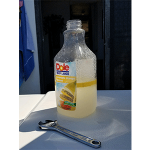cricketman
Cadet
- Joined
- Sep 26, 2016
- Messages
- 8
I have a Honda BF 130 on the back of a 12x50 Catamaran Cruiser (a catamaran-style houseboat). It's a 2000 model, and has given me great service for the last 16 years.
Recently however, it left me stranded (not fun being towed in a 12x50 houseboat - but thank goodness for Sea Tow!).
The verdict was water in the fuel system, so we added a water/fuel separator between the tank & the engine, replaced the fuel hose that runs from the tank to the engine, and replaced one fuel line on the engine that had a broken plastic fitting on it (which may have happened during the checkout/repair process but that's fine - must have had a small crack so glad it's replaced).
After those repairs, the next weekend she cranked right away & ran fine for the 30 mins it took us to get to a beach to set up camp for the weekend.
Then on Sun evening when it was time to head back to the marina, she wouldn't crank. Suspecting water in the fuel again, I first checked the new water/fuel separator we added between the tank & the engine. Removed it, dumped it into a clear jug and it was all fuel - not a drop of water. I then removed the pressure check bolt from the fuel pump and ran the pump some - sure enough there was water there. We pushed out two 16 oz bottles that were about 80% WATER before we started getting pure fuel again.
She then fired up, ran rough for a minute or so, then settled out & ran like a brand new one for the 30 mins back to marina where she sat in a covered slip for the last week.
Then this past weekend, same scenario - cranked fine on Friday afternoon, got to beach fine, then on Sat would not crank. Checked the water/fuel separator again - all clear - no water. Removed that bolt-plug from fuel pump again & ran over a QUART of water out before getting to pure fuel. Then she cranked fine & we got back home.
I cannot figure out WHERE this water is coming from!
It is definitely getting into the system somewhere between that new water/fuel separator filter & the fuel pump.
I see no indication of any gas leaks anywhere.
When we're "at rest" at a beach, with the front of the boat pushed up on the beach, the rear sits a little lower than it does when she's level in the slip which results in the exhaust ports on the engine being under the water an inch or two. Someone this weekend suggested water could be entering through those exhaust ports, but I didn't think that was possible - thoughts? (I am not an engine expert so forgive me if that's a stupid question.)
Any and all thoughts are greatly appreciated!!!
Recently however, it left me stranded (not fun being towed in a 12x50 houseboat - but thank goodness for Sea Tow!).
The verdict was water in the fuel system, so we added a water/fuel separator between the tank & the engine, replaced the fuel hose that runs from the tank to the engine, and replaced one fuel line on the engine that had a broken plastic fitting on it (which may have happened during the checkout/repair process but that's fine - must have had a small crack so glad it's replaced).
After those repairs, the next weekend she cranked right away & ran fine for the 30 mins it took us to get to a beach to set up camp for the weekend.
Then on Sun evening when it was time to head back to the marina, she wouldn't crank. Suspecting water in the fuel again, I first checked the new water/fuel separator we added between the tank & the engine. Removed it, dumped it into a clear jug and it was all fuel - not a drop of water. I then removed the pressure check bolt from the fuel pump and ran the pump some - sure enough there was water there. We pushed out two 16 oz bottles that were about 80% WATER before we started getting pure fuel again.
She then fired up, ran rough for a minute or so, then settled out & ran like a brand new one for the 30 mins back to marina where she sat in a covered slip for the last week.
Then this past weekend, same scenario - cranked fine on Friday afternoon, got to beach fine, then on Sat would not crank. Checked the water/fuel separator again - all clear - no water. Removed that bolt-plug from fuel pump again & ran over a QUART of water out before getting to pure fuel. Then she cranked fine & we got back home.
I cannot figure out WHERE this water is coming from!
It is definitely getting into the system somewhere between that new water/fuel separator filter & the fuel pump.
I see no indication of any gas leaks anywhere.
When we're "at rest" at a beach, with the front of the boat pushed up on the beach, the rear sits a little lower than it does when she's level in the slip which results in the exhaust ports on the engine being under the water an inch or two. Someone this weekend suggested water could be entering through those exhaust ports, but I didn't think that was possible - thoughts? (I am not an engine expert so forgive me if that's a stupid question.)
Any and all thoughts are greatly appreciated!!!




















